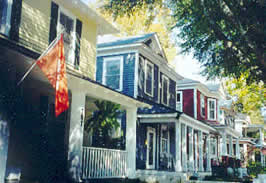 |
||||||





"Among the first lessons the preservationist learns
is that the legal power to protect historic places lies chiefly with local
government. This is a lesson often learned the hard way, for many people
assume that the federal government, being the 'highest' level of government,
is the strongest guardian of historic sites. This, unfortunately, is not
the case…"
Constance E. Beaumont, from A Citizen's Guide to
Protecting Historic Places: Local Preservation Ordinances, 1992. National
Trust for Historic Preservation.
Here's what one State says about how National Register listing and local designations can work together effectively in communities:
Preservation Hotline #2:
National Register listing/Local designation
South Carolina Department of Archives and History
State Historic Preservation Office
Communities across South Carolina are using National Register listing and local designation to help preserve their historic properties. Both designations recognize and encourage the protection of historic properties, but they are quite different. They are complementary programs that can work effectively either independently or together to meet the historic preservation needs of a community.
National Register Listing
The National Register is the nation's official list of historic, architectural, and archaeological resources worthy of preservation. South Carolina has about 1,200 listings in the National Register, both individual properties and historic districts.
Authority and Administration: In 1966, the National Historic Preservation Act created the National Register and established federal listing criteria. Each state and territory has a State Historic Preservation Officer who identifies eligible properties and, in conjunction with a State Board of Review, submits nominations to the Keeper of the National Register at the United States Department of the Interior.
Protection: Properties listed in the National Register are eligible for preservation tax credits and preservation grants, and they receive some protection from the potential adverse effects of federal projects (funded, licensed, or approved) or projects requiring certain State certifications or permits. National Register properties that are owned or leased by the State also receive some protection.
Local Designation
Local governments can adopt a historic preservation-zoning ordinance, which enables them to designate properties of historical or architectural significance. Usually, the local governing body, guided by the recommendations of its planning, zoning, and historic preservation commissions, chooses the properties. Some thirty cities, towns, and counties in South Carolina have designated local historic districts and individual landmarks by adopting this kind of ordinance…
Authority and Administration: South Carolina cities, towns, and counties can enact zoning laws that provide for "the preservation and protection of historic and architecturally valuable districts and neighborhoods" under South Carolina law S6-29-870. Historic preservation zoning stresses building appearance rather than use.
Protection: A historic preservation zoning ordinance can establish a board of citizens—often called a historic preservation commission, design review commission, town appearance committee, board of architectural review, or historic district commission—to review proposed changes to locally designated historic properties. The ordinance protects historic properties by requiring board approval before property owners can build, demolish, or make alterations within designated areas.
---------------------------------